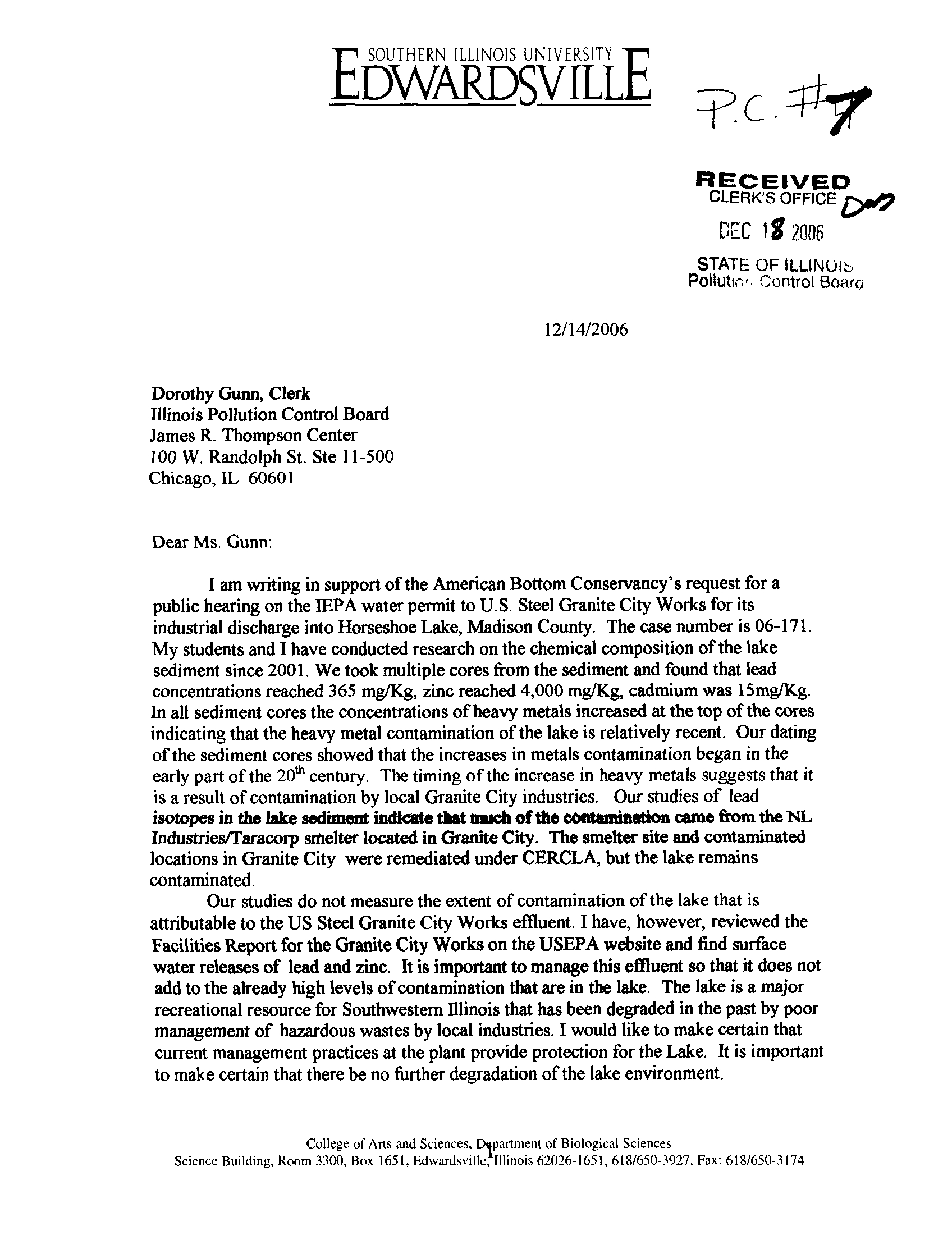Dorothy Gunn, Clerk
Illinois Pollution Control Board
James R. Thompson Center
100 W. Randolph St . Ste 11-500
Chicago, IL 60601
Dear Ms . Gunn :
I am writing in support of the American Bottom Conservancy's request for a
public hearing on the IEPA water permit to U.S
. Steel Granite City Works for its
industrial discharge into Horseshoe Lake, Madison County
. The case number is 06-171 .
My students and I have conducted research on the chemical composition of the lake
sediment since 2001 . We took multiple cores from the sediment and found that lead
concentrations reached 365 mg/Kg, zinc reached 4,000 mg/Kg, cadmium was 15mg/Kg
.
In all sediment cores the concentrations of heavy metals increased at the top of the cores
indicating that the heavy metal contamination of the lake is relatively recent . Our dating
of the sediment cores showed that the increases in metals contamination began in the
early part of the 20th century
. The timing of the increase in heavy metals suggests that it
is a result of contamination by local Granite City industries . Our studies of lead
isotopes in the lake sediment indicate that touch of the
ration came from the NL
Industries/Taracorp smelter located in Granite City
. The smelter site and contaminated
locations in Granite City were remediated under CERCLA, but the lake remains
contaminated .
Our studies do not measure the extent of contamination of the lake that is
attributable to the US Steel Granite City Works effluent
. I have, however, reviewed the
Facilities Report for the Granite City Works on the USEPA website and find surface
water releases of lead and zinc . It is important to manage this effluent so that it does not
add to the already high levels of contamination that are in the lake
. The lake is a major
recreational resource for Southwestern Illinois that has been degraded in the past by poor
management of hazardous wastes by local industries
. I would like to make certain that
current management practices at the plant provide protection for the Lake
. It is important
to make certain that there be no further degradation of the lake environment
.
College of Arts and Sciences, Dgpartment of Biological Sciences
Science Building, Room 3300, Box 1651, Edwardsville, Illinois 62026-1651, 618/650-3927, Fax : 618/650-3174
EDW `ARDSVILLE
12/14/2006
RECEIVED
CLERK'S OFFICE
rNawV
DEC
18 2006
Polluting
STATE
:
OF
Control
ILLINOIb
Boaro
Our studies are available online in the following locations
:
Brugam, R.B ., I . Bala,B. Vermillion, W. Retzlaff 2002 . Historical impact of
industrial development on Groundwater and surface water quality in the American
bottoms Progress Report 1, Illinois Groundwater Consortium . 9 pp
http://www.siu .edu/orda/igc/proceedings/02/brugam .pdf
Brugam, R.B., I . Bala,B. Vermillion, W. Retzlaff 2003 . Historical impact of
industrial development on Groundwater and surface water quality in the American
bottoms Progress Report 2,
Illinois Groundwater Consortium
.
l7pp
http://www.siu .edu/orda/igc/proceedings/03/brugam .pdf
Brugam, R.B., I . Bala, J. Martin, B . Vermilion, and W. Retzlaff. 2003 . The
Sedimentary Record of Environmental Contamination in Horseshoe Lake, Madison
County, Illinois
.
Transactions of the Illinois State Academy ofScience 96 :205-218 .
http://www.il-st-acad-sci .org/transactions/PDF/9620 .pdf
Vermillion, B, Brugam, R ., RetzlaffZ W . and Bala, I. 2005
. The sedimentary
record of environmental lead contamination at St . Louis, Missouri, U .S.A. area smelters.
Journal ofPaleolimnology 33 :189-203 .
http://www.springerlink.com/content/r422372152714uOV?p=26d2074ee l a54d98bi96cbec
b11a9a03&pi=0
Yours truly,
G
Richard B. Brugam
Professor
2
